Potřebujeme váš souhlas k využití jednotlivých dat, aby se vám mimo jiné mohly ukazovat informace týkající se vašich zájmů. Souhlas udělíte kliknutím na tlačítko „OK“.
ASTM D5311/D5311M-13
Standard Test Method for Load Controlled Cyclic Triaxial Strength of Soil (Withdrawn 2022)
Automaticky přeložený název:
Standardní zkušební metoda pro zatížení kontrolované Cyklické Triaxial pevnosti půdy
NORMA vydána dne 1.11.2013
Informace o normě:
Označení normy: ASTM D5311/D5311M-13
Poznámka: NEPLATNÁ
Datum vydání normy: 1.11.2013
Kód zboží: NS-30694
Počet stran: 11
Přibližná hmotnost: 33 g (0.07 liber)
Země: Americká technická norma
Kategorie: Technické normy ASTM
Kategorie - podobné normy:
Zemní práce. Hloubicí práce. Budování základů. Podzemní práce
Anotace textu normy ASTM D5311/D5311M-13 :
Keywords:
consolidated-undrained tests, cohesionless soils, laboratory tests, liquefaction, triaxial tests, ICS Number Code 93.020 (Earth works. Excavations. Foundation construction. Underground works)
Doplňující informace
| Significance and Use | ||||||||||||||||||||||||||
|
5.1 Cyclic triaxial strength test results are used for evaluating the ability of a soil to resist the shear stresses induced in a soil mass due to earthquake or other cyclic loading. 5.1.1 Cyclic triaxial strength tests may be performed at different values of effective confining pressure on isotropically consolidated specimens to provide data required for estimating the cyclic stability of a soil. 5.1.2 Cyclic triaxial strength tests may be performed at a single effective confining pressure, usually equal to 100 kN/m2 [14.5 lb/in.2], or alternate pressures as appropriate on isotropically consolidated specimens to compare cyclic strength results for a particular soil type with that of other soils, Ref (2). 5.2 The cyclic triaxial test is a commonly used technique for determining cyclic soil strength. 5.3 Cyclic strength depends upon many factors, including density, confining pressure, applied cyclic shear stress, stress history, grain structure, age of soil deposit, specimen preparation procedure, and the frequency, uniformity, and shape of the cyclic wave form. Thus, close attention must be given to testing details and equipment. 5.4 There are certain limitations inherent in using cyclic triaxial tests to simulate the stress and strain conditions of a soil element in the field during an earthquake. 5.4.1 Nonuniform stress conditions within the test specimen are imposed by the specimen end platens. This can cause a redistribution of void ratio within the specimen during the test. 5.4.2 A 90° change in the direction of the major principal stress occurs during the two halves of the loading cycle on isotropically consolidated specimens. 5.4.3 The maximum cyclic shear stress that can be applied to the specimen is controlled by the stress conditions at the end of consolidation and the pore-water pressures generated during testing. For an isotropically consolidated contractive (volume decreasing) specimen tested in cyclic compression, the maximum cyclic shear stress that can be applied to the specimen is equal to one-half of the initial total axial pressure. Since cohesionless soils are not capable of taking tension, cyclic shear stresses greater than this value tend to lift the top platen from the soil specimen. Also, as the pore-water pressure increases during tests performed on isotropically consolidated specimens, the effective confining pressure is reduced, contributing to the tendency of the specimen to neck during the extension portion of the load cycle, invalidating test results beyond that point. 5.4.4 While it is advised that the best possible intact specimens be obtained for cyclic strength testing, it is sometimes necessary to reconstitute soil specimens. It has been shown that different methods of reconstituting specimens to the same density may result in significantly different cyclic strengths. Also, intact specimens will almost always be stronger than reconstituted specimens. 5.4.5 The interaction between the specimen, membrane, and confining fluid has an influence on cyclic behavior. Membrane compliance effects cannot be readily accounted for in the test procedure or in interpretation of test results. Changes in porewater pressure can cause changes in membrane penetration in specimens of cohesionless soils. These changes can significantly influence the test results. 5.4.6 The mean total confining pressure is asymmetric during the compression and extension stress application when the chamber pressure is constant. This is totally different from the symmetric stress in the simple shear case of the level ground liquefaction. 1.1 This test method covers the
determination of the cyclic strength (sometimes called the
liquefaction potential) of saturated soils in either intact or
reconstituted states by the load-controlled cyclic triaxial
technique.
1.2 The cyclic strength of a soil is evaluated relative to a number of factors, including: the development of axial strain, magnitude of applied cyclic stress, number of cycles of stress application, development of excess pore-water pressure, and state of effective stress. A comprehensive review of factors affecting cyclic triaxial test results is contained in the literature (1).2 1.3 Cyclic triaxial strength tests are conducted under undrained conditions to simulate essentially undrained field conditions during earthquake or other cyclic loading. 1.4 Cyclic triaxial strength tests are destructive. Failure may be defined on the basis of the number of stress cycles required to reach a limiting strain or 100 % pore pressure ratio. See Section 3 for Terminology. 1.5 This test method is generally applicable for testing cohesionless free draining soils of relatively high permeability. When testing well-graded materials, silts, or clays, pore-water pressures monitored at the specimen ends may not represent pore-water pressure values throughout the specimen. However, this test method may be followed when testing most soil types if care is taken to ensure that problem soils receive special consideration when tested and when test results are evaluated. 1.6 All observed and calculated values shall conform to the guide for significant digits and rounding established in Practice D6026. The procedures in Practice D6026 that are used to specify how data are collected, recorded, and calculated are regarded as the industry standard. In addition, they are representative of the significant digits that should generally be retained. The procedures do not consider material variation, purpose for obtaining the data, special purpose studies, or any considerations for the objectives of the user. Increasing or reducing the significant digits of reported data to be commensurate with these considerations is common practice. Consideration of the significant digits to be used in analysis methods for engineering design is beyond the scope of this standard. 1.6.1 The method used to specify how data are collected, calculated, or recorded in this standard is not directly related to the accuracy to which the data can be applied in design or other uses, or both. How one applies the results obtained using this standard is beyond its scope. 1.7 The values stated in either SI units or inch-pound units [presented in brackets] are to be regarded separately as standard. The values stated in each system may not be exact equivalents; therefore, each system shall be used independently of the other. Combining values from the two systems may result in non-conformance with the standard. Reporting of test results in units other than SI shall not be regarded as nonconformance with this test method. 1.8 This standard does not purport to address all of the safety concerns, if any, associated with its use. It is the responsibility of the user of this standard to establish appropriate safety and health practices and determine the applicability of regulatory limitations prior to use. |
||||||||||||||||||||||||||
| 2. Referenced Documents | ||||||||||||||||||||||||||
|
Podobné normy:
Historická
1.5.2006
Historická
1.5.2012
Historická
15.11.2007
Historická
1.10.2008
Historická
15.5.2013
Historická
1.4.2008
Odebírejte informace o nově vydaných normách ZDARMA:
Chcete pravidelně odebírat informace o nově vycházejících normách z celého světa a to zcela zdarma?
Přihlašte se k odběru. Vše je velice jednoduché a absolutně ZDARMA.
Na výběr máte vydavatele z celého světa.


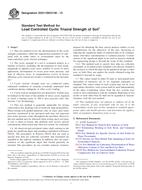
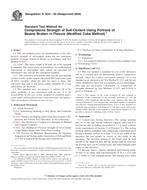 ASTM D1634-00(2006)..
ASTM D1634-00(2006)..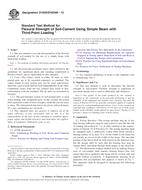 ASTM D1635/D1635M-12..
ASTM D1635/D1635M-12.. ASTM D1883-07e2
ASTM D1883-07e2 ASTM D2113-08
ASTM D2113-08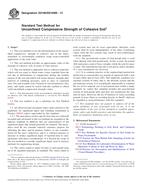 ASTM D2166/D2166M-13..
ASTM D2166/D2166M-13..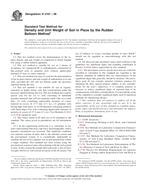 ASTM D2167-08
ASTM D2167-08
 Cookies
Cookies
